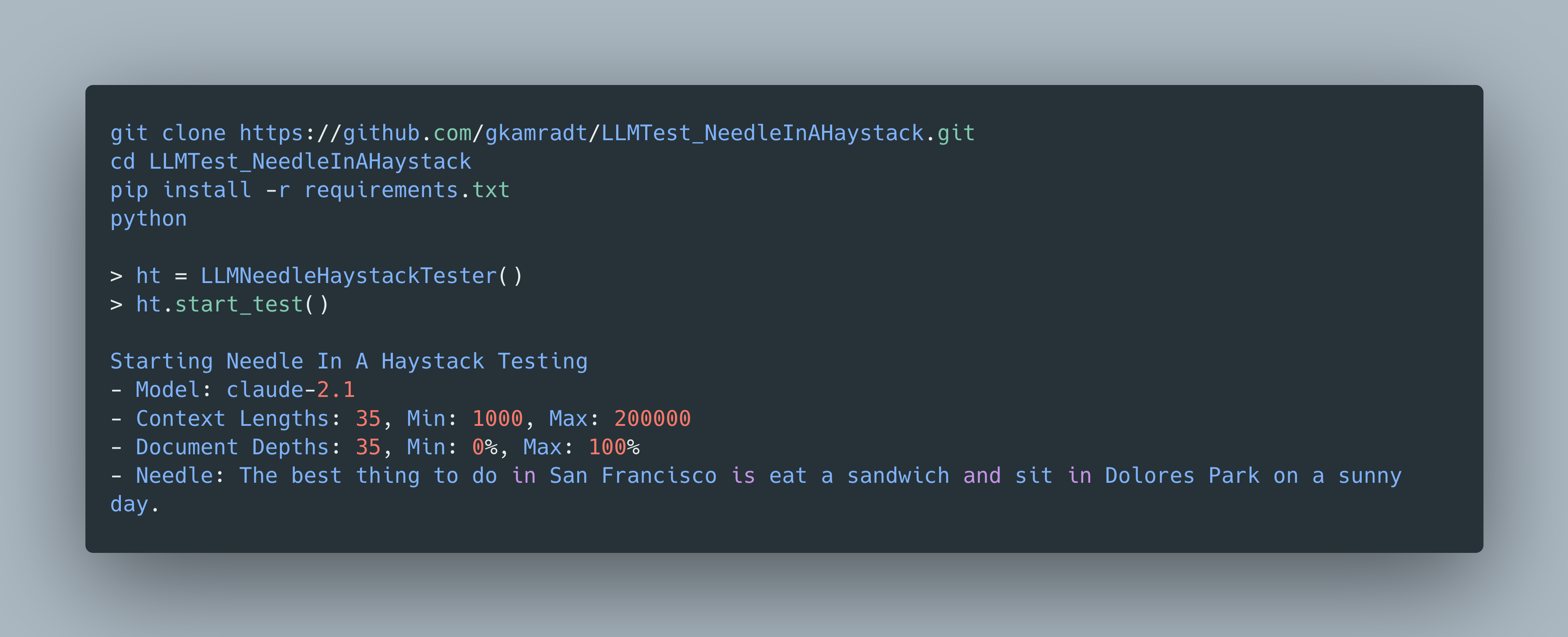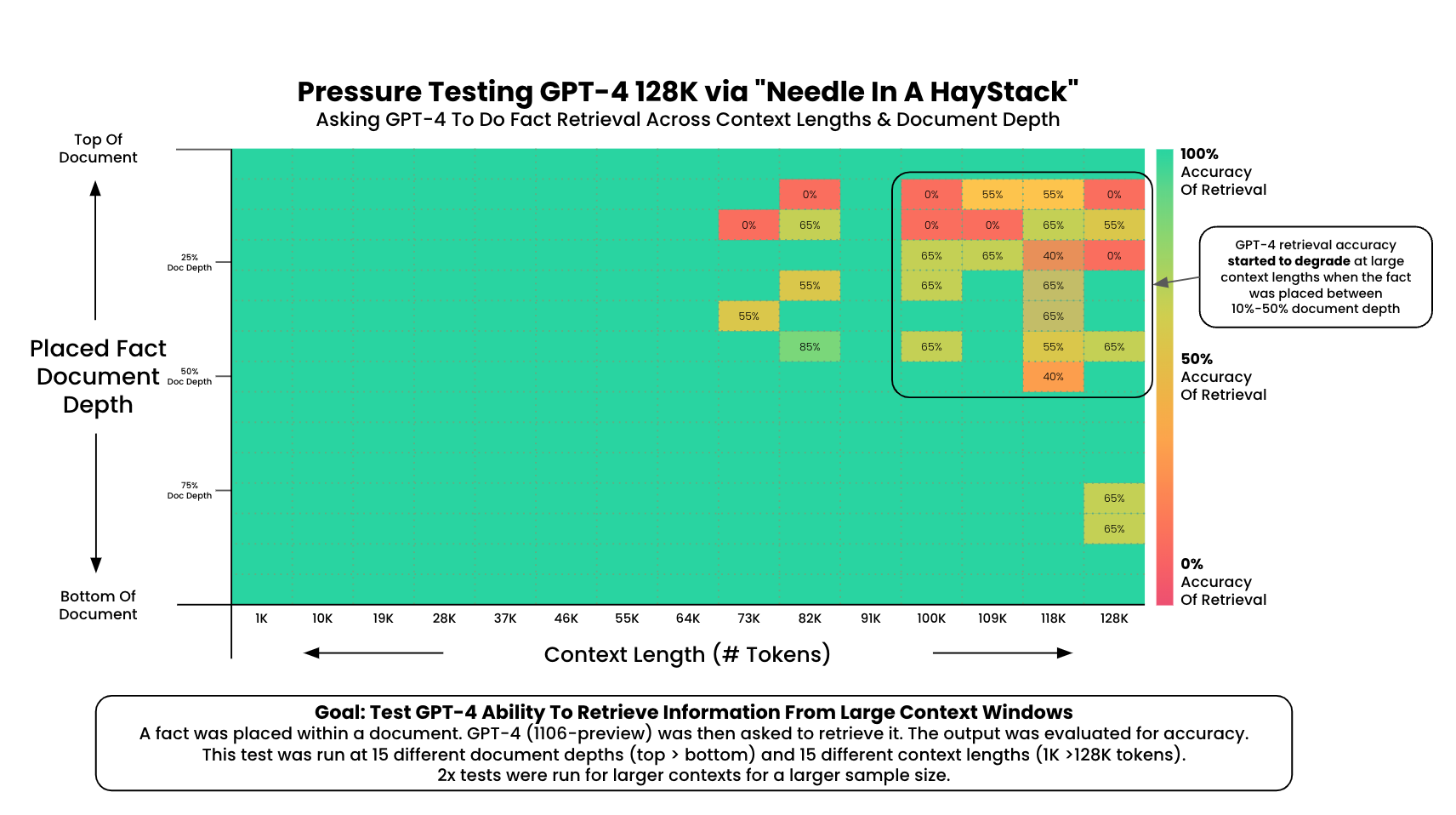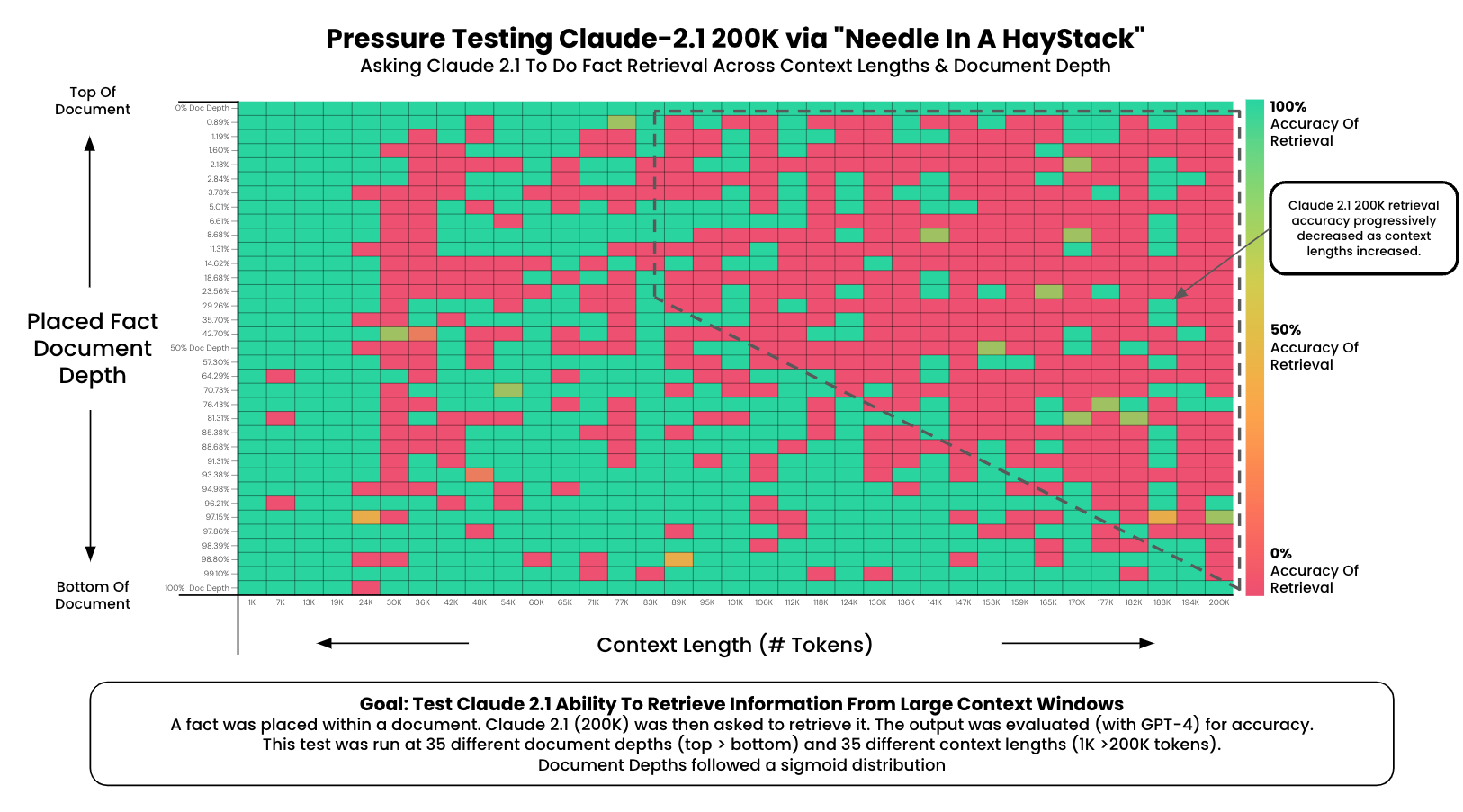Supported model providers: OpenAI, Anthropic
A simple 'needle in a haystack' analysis to test in-context retrieval ability of long context LLMs.
Get the behind the scenes on the overview video.
$ git clone https://github.com/gkamradt/LLMTest_NeedleInAHaystack.git
$ make setup
$ source ./venv/bin/activate
$ pip install -r requirements.txtYou can then run the analysis on OpenAI or Anthropic models by running main.py with the command line arguments shown below. LLMNeedleHaystackTester parameters can also be passed as command line arguments, except model_to_test and evaluator of course.
provider- The provider of the model, available options areopenaiandanthropic. Defaults toopenaievaluator- The evaluator, which can either be amodelorLangSmith. See more onLangSmithbelow. If using amodel, onlyopenaiis currently supported. Defaults toopenai.api_key- API key for either OpenAI or Anthropic provider. Can either be passed as a command line argument or an environment variable namedOPENAI_API_KEYorANTHROPIC_API_KEYdepending on the provider. Defaults toNone.evaluator_api_key- API key for OpenAI provider. Can either be passed as a command line argument or an environment variable namedOPENAI_API_KEY. Defaults toNone
- Place a random fact or statement (the 'needle') in the middle of a long context window (the 'haystack')
- Ask the model to retrieve this statement
- Iterate over various document depths (where the needle is placed) and context lengths to measure performance
This is the code that backed this OpenAI and Anthropic analysis.
If ran and save_results = True, then this script will populate a result/ directory with evaluation information. Due to potential concurrent requests each new test will be saved as a few file.
I've put the results from the original tests in /original_results. I've upgraded the script since those test were ran so the data formats may not match your script results.
LLMNeedleHaystackTester parameters:
model_to_test- The model to run the needle in a haystack test on. Default is None.evaluator- An evaluator to evaluate the model's response. Default is None.needle- The statement or fact which will be placed in your context ('haystack')haystack_dir- The directory which contains the text files to load as background context. Only text files are supportedretrieval_question- The question with which to retrieve your needle in the background contextresults_version- You may want to run your test multiple times for the same combination of length/depth, change the version number if sonum_concurrent_requests- Default: 1. Set higher if you'd like to run more requests in parallel. Keep in mind rate limits.save_results- Whether or not you'd like to save your results to file. They will be temporarily saved in the object regardless. True/Falsesave_contexts- Whether or not you'd like to save your contexts to file. Warning these will get very long. True/Falsefinal_context_length_buffer- The amount of context to take off each input to account for system messages and output tokens. This can be more intelligent but using a static value for now. Default 200 tokens.context_lengths_min- The starting point of your context lengths list to iteratecontext_lengths_max- The ending point of your context lengths list to iteratecontext_lengths_num_intervals- The number of intervals between your min/max to iterate throughcontext_lengths- A custom set of context lengths. This will override the values set forcontext_lengths_min, max, and intervals if setdocument_depth_percent_min- The starting point of your document depths. Should be int > 0document_depth_percent_max- The ending point of your document depths. Should be int < 100document_depth_percent_intervals- The number of iterations to do between your min/max pointsdocument_depth_percents- A custom set of document depths lengths. This will override the values set fordocument_depth_percent_min, max, and intervals if setdocument_depth_percent_interval_type- Determines the distribution of depths to iterate over. 'linear' or 'sigmoidseconds_to_sleep_between_completions- Default: None, set # of seconds if you'd like to slow down your requestsprint_ongoing_status- Default: True, whether or not to print the status of test as they complete
LLMMultiNeedleHaystackTester parameters:
multi_needle- True or False, whether to run multi-needleneedles- List of needles to insert in the context
Other Parameters:
api_key- API key for either OpenAI or Anthropic provider. Can either be passed when creating the object or an environment variablemodel_name- The name of the model you'd like to use. Should match the exact value which needs to be passed to the api. Ex: For OpenAI inference and evaluator models it would begpt-3.5-turbo-0125.
LLMNeedleInHaystackVisualization.ipynb holds the code to make the pivot table visualization. The pivot table was then transferred to Google Slides for custom annotations and formatting. See the google slides version. See an overview of how this viz was created here.
To enable multi-needle insertion into our context, use --multi_needle True.
This inserts the first needle at the specified depth_percent, then evenly distributes subsequent needles through the remaining context after this depth.
For even spacing, it calculates the depth_percent_interval as:
depth_percent_interval = (100 - depth_percent) / len(self.needles)
So, the first needle is placed at a depth percent of depth_percent, the second at depth_percent + depth_percent_interval, the third at depth_percent + 2 * depth_percent_interval, and so on.
Following example shows the depth percents for the case of 10 needles and depth_percent of 40%.
depth_percent_interval = (100 - 40) / 10 = 6
Needle 1: 40
Needle 2: 40 + 6 = 46
Needle 3: 40 + 2 * 6 = 52
Needle 4: 40 + 3 * 6 = 58
Needle 5: 40 + 4 * 6 = 64
Needle 6: 40 + 5 * 6 = 70
Needle 7: 40 + 6 * 6 = 76
Needle 8: 40 + 7 * 6 = 82
Needle 9: 40 + 8 * 6 = 88
Needle 10: 40 + 9 * 6 = 94
You can use LangSmith to orchestrate evals and store results.
(1) Sign up for LangSmith
(2) Set env variables for LangSmith as specified in the setup.
(3) In the Datasets + Testing tab, use + Dataset to create a new dataset, call it multi-needle-eval-sf to start.
(4) Populate the dataset with a test question:
question: What are the 5 best things to do in San Franscisco?
answer: "The 5 best things to do in San Francisco are: 1) Go to Dolores Park. 2) Eat at Tony's Pizza Napoletana. 3) Visit Alcatraz. 4) Hike up Twin Peaks. 5) Bike across the Golden Gate Bridge"
 (5) Run with
(5) Run with --evaluator langsmith and --eval_set multi-needle-eval-sf to run against our recently created eval set.
Let's see all these working together on a new dataset, multi-needle-eval-pizza.
Here is the multi-needle-eval-pizza eval set, which has a question and reference answer. You can also and resulting runs:
https://smith.langchain.com/public/74d2af1c-333d-4a73-87bc-a837f8f0f65c/d
Here is the command to run this using multi-needle eval and passing the relevant needles:
python main.py --evaluator langsmith --context_lengths_num_intervals 3 --document_depth_percent_intervals 3 --provider openai --model_name "gpt-4-0125-preview" --multi_needle True --eval_set multi-needle-eval-pizza --needles '["Figs are one of the three most delicious pizza toppings.", "Prosciutto is one of the three most delicious pizza toppings.", "Goat cheese is one of the three most delicious pizza toppings."]'
This project is licensed under the MIT License - see the LICENSE file for details. Use of this software requires attribution to the original author and project, as detailed in the license.


